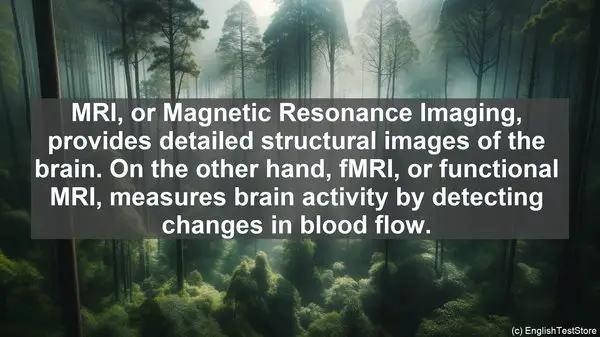Introduction
Hello everyone, and welcome to today’s lesson! Neuroimaging is a fascinating field, but it comes with its fair share of confusing terminology. In this lesson, we’ll be tackling the top 10 commonly confused words in neuroimaging. So, let’s dive right in!

1. fMRI vs. MRI
First up, we have fMRI and MRI. While both are imaging techniques used in neurology, they serve different purposes. MRI, or Magnetic Resonance Imaging, provides detailed structural images of the brain. On the other hand, fMRI, or functional MRI, measures brain activity by detecting changes in blood flow. So, MRI gives us the ‘what’ of the brain, while fMRI gives us the ‘how’ and ‘when’.
2. Sensitivity vs. Specificity
Next, let’s talk about sensitivity and specificity. These terms are often used when discussing the accuracy of a diagnostic test. Sensitivity refers to the test’s ability to correctly identify individuals with a particular condition. Specificity, on the other hand, measures the test’s ability to correctly identify individuals without the condition. In neuroimaging, both sensitivity and specificity are crucial for accurate diagnoses.
3. Gray Matter vs. White Matter
Moving on, we have gray matter and white matter. These are two types of tissue in the brain, and they have distinct functions. Gray matter contains the cell bodies of neurons and is involved in information processing. White matter, on the other hand, consists of nerve fibers and is responsible for transmitting signals between different brain regions. Both gray and white matter play essential roles in brain function.
4. PET vs. SPECT
Now, let’s compare PET and SPECT. Both are nuclear medicine imaging techniques that involve the use of radioactive tracers. PET, or Positron Emission Tomography, provides functional information by measuring the distribution of the tracer in the body. SPECT, or Single-Photon Emission Computed Tomography, uses a similar principle but with a different type of tracer. Both PET and SPECT have their applications in neuroimaging, depending on the specific clinical question.

5. Sensitivity vs. Resolution
In neuroimaging, sensitivity and resolution are two important factors. Sensitivity refers to the ability of the imaging technique to detect subtle changes or abnormalities. Resolution, on the other hand, measures the level of detail that can be captured. While high sensitivity is crucial for detecting small changes, high resolution is necessary for precise localization. The choice of imaging technique often depends on the balance between sensitivity and resolution required for a particular study.
6. Voxel vs. Region of Interest
When analyzing neuroimaging data, two common terms are voxel and region of interest. A voxel, short for volume element, is the smallest unit of a three-dimensional image. It’s like a pixel in a two-dimensional image. A region of interest, on the other hand, is a specific area or volume within the image that researchers focus on. Both voxels and regions of interest are essential for extracting meaningful information from neuroimaging data.
7. BOLD vs. CBV
BOLD and CBV are two types of functional neuroimaging signals. BOLD, which stands for Blood Oxygenation Level Dependent, is based on changes in blood oxygenation. It’s the most commonly used signal in fMRI. CBV, or Cerebral Blood Volume, measures the amount of blood in a particular brain region. Both BOLD and CBV provide valuable insights into brain activity, but they capture different aspects of it.
8. Diffusion vs. Perfusion
Next, let’s discuss diffusion and perfusion. These terms are often used in the context of MRI. Diffusion refers to the movement of water molecules in tissue. It’s particularly useful for studying the integrity of white matter tracts. Perfusion, on the other hand, measures the blood flow to a particular area. It’s crucial for assessing tissue viability. Both diffusion and perfusion imaging have their applications in various neurological conditions.
9. Artifact vs. Signal
When interpreting neuroimaging data, distinguishing between artifacts and signals is essential. An artifact is any unwanted or spurious feature in the image that doesn’t reflect the underlying biology. It can be caused by various factors, such as motion or scanner-related issues. A signal, on the other hand, represents the true biological information. Differentiating between artifacts and signals is crucial for accurate data interpretation.
10. ROI vs. Whole-Brain Analysis
Lastly, let’s talk about ROI and whole-brain analysis. ROI, or Region of Interest analysis, involves focusing on specific brain regions or networks. It’s often used when the research question is targeted. Whole-brain analysis, as the name suggests, involves analyzing the entire brain. It’s useful for exploratory studies or when the research question is broad. Both ROI and whole-brain analysis have their advantages and are used in different research contexts.
